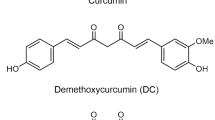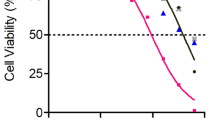Purpose
Triamcinolone acetonide (TA) is a corticosteroid that can be used in the treatment of cystoid macular edema (CME) and other ocular inflammatory conditions. This study aims to investigate the degree of cytotoxic effect of TA on human retinal pigment epithelium (ARPE19 cell line) and to compare the relative toxicity of TA with two other corticosteroids, hydrocortisone (HC) and dexamethasone (DEX), over a range of concentrations and durations of exposure.
Methods
The ARPE19 cell line was cultured and maintained in a 1:1 mixture of Dulbecco’s modified Eagle’s medium and HAMS F12 medium containing 3 mM l-glutamine supplemented with 10% fetal bovine serum, penicillin G, and streptomycin sulfate. Following an initial overnight incubation, corticosteroids (0.01–1 mg/ml) or vehicle (benzyl alcohol, 0.025%), diluted in culture medium, was added to the ARPE19 culture (5000 cells/well) on Day 0. Subsequently the culture medium containing corticosteroid or vehicle was refreshed daily. After 1, 3, and 5 days, the proliferated amount of cells with and without corticosteroid treatment was determined using a 3-(4,5-dimethylthiazol-2-yl)-2,5-diphenyltetrazolium bromide (MTT) assay. All samples were read in triplicate, with n = 4 in all cases. The final results were analyzed using analysis of variance.
Results
TA, DEX, and HC caused a significant reduction in cell numbers throughout the whole range of concentrations when cells were exposed to them for more than one day. The action of the corticosteroids, apart from TA, was biphasic. There was an initial rise in cell proliferation in the presence of DEX and HC at 0.01–0.1 mg/ml on Day 1. Log-linear plots of DEX and HC concentrations against percent viability (mean % ± SD) showed a significantly higher total viable cell percentage versus TA: 120.5 ± 1.8% and 134.9 ± 4.1% in the presence of DEX, and 110.0 ± 15.3% and 118.3 ± 9.0% in the presence of HC. The LD50 values of the three corticosteroids show that, regardless of the duration of exposure, TA was the most toxic, with relative toxicity of TA > DEX > HC, equivalent to a ratio of 1.0 : 1.6 : 1.8, after one day of incubation. The vehicle alone had no effect.
Conclusions
The present study demonstrated the degree of cytotoxicity of TA compared with DEX and HC. The results provide a profile of this drug relative to other common corticosteroids. Further studies are planned to characterize its effects and the degree of influence on cells of different ocular regions in order to show the full cytotoxicity of TA.
Similar content being viewed by others
Author information
Authors and Affiliations
Corresponding author
About this article
Cite this article
Yeung, C., Chan, K., Chan, C. et al. Cytotoxicity of Triamcinolone on Cultured Human Retinal Pigment Epithelial Cells: Comparison with Dexamethasone and Hydrocortisone. Jpn J Ophthalmol 48, 236–242 (2004). https://doi.org/10.1007/s10384-003-0053-8
Received:
Accepted:
Published:
Issue Date:
DOI: https://doi.org/10.1007/s10384-003-0053-8




